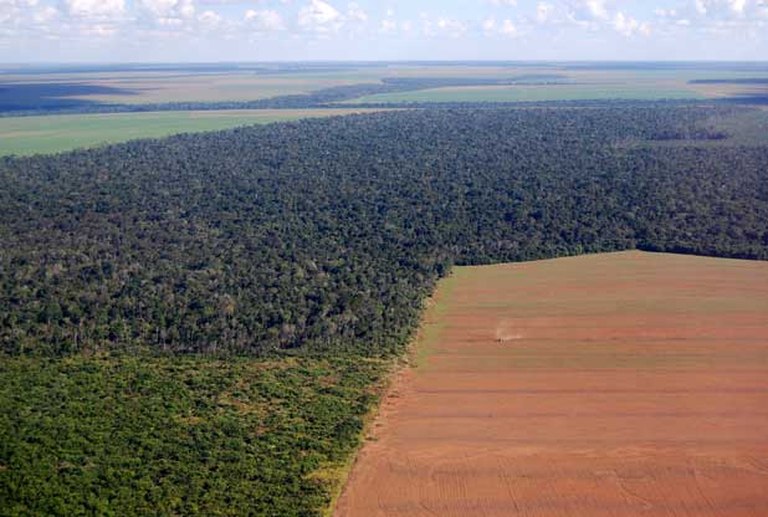
The Amazon became an alternative classroom during the pandemic. Now, the educational forest in Batraja, Bolivia, lives on to teach children and adults the value of nature.
According to a WWF report, the average European citizen eats 61 kg of soy yearly, 93 percent of which is hidden as animal feed in meat, fish, eggs and dairy products.
According to a new study commissioned by the WWF, people don’t need to drink soy milk or eat tofu to ingest this ingredient: in Europe, the average citizen unconsciously consumes 57 kg of soy per year (93 percent of total consumption) through animal foods.
The research report Mapping the Soy Supply Chain in Europe reveals that the highest amount of soy (109 g per 100 g of product) was found in chicken breast, followed by eggs (35 g of soy per a 55 g egg), salmon steaks (59 g per 100 g), pork chops (51 g in 100 g of meat), hamburgers (46 g per 100 g) and cheese (25 g per 100 g of cheese). Therefore, soy is a hidden ingredient that causes severe deforestation worldwide and that is mostly produced from genetically modified crops that don’t appear on the final product label.

As the WWF has highlighted, this is an environmental issue because forests, pastures and savannas are going to disappear to make room for soy plantations. The GMO issue shouldn’t be ignored too. Actually, almost all soy used for conventional feed (which is not certified by the organic agriculture or the GMO-free short supply chain) is genetically modified. GM soy is cultivated in Argentina, United States, Canada, Mexico, Costa Rica, Bolivia, Chile, Brazil, Uruguay, Paraguay, South Africa and imported to Europe to be used as fodder.

The WWF, in order to raise awareness among European consumers, launched an interactive infographic in social media, a kind of virtual fridge where people can find out how much soy is hidden in some foods they eat daily. “Most European consumers have no idea how much soy is embedded in their favourite meat, dairy, eggs and farmed fish products” claimed Sandra Mulder, head of the WWF’s soy team. “Even less understood is how this hidden soy has had a devastating impact on some of the worlds’ most valuable ecosystems, such as the Amazon, Cerrado and Gran Chaco”.

“WWF feels that a crucial short term strategy is for companies that buy soy or animal products raised with soy in Europe to make commitments to responsible soy and start buying it now. This will send an immediate message to producers in South America that EU buyers want soy that has not been produced at the expense of nature, soy workers or communities in soy growing areas”.
GMOs are banned in organic farming and farmers are not allowed to feed their animals on GM fodder.
Siamo anche su WhatsApp. Segui il canale ufficiale LifeGate per restare aggiornata, aggiornato sulle ultime notizie e sulle nostre attività.
![]()
Quest'opera è distribuita con Licenza Creative Commons Attribuzione - Non commerciale - Non opere derivate 4.0 Internazionale.
The Amazon became an alternative classroom during the pandemic. Now, the educational forest in Batraja, Bolivia, lives on to teach children and adults the value of nature.
Our species took its first steps in a world covered in trees. Today, forests offer us sustenance, shelter, and clean the air that we breathe.
Bangladesh suffered widespread damage as a result of Cyclone Amphan. Yet the Sundarbans mangrove forest acted as a natural barrier protecting the country from further destruction, as it has done countless times before.
On top of a 2.4 million dollar compensation, the indigenous Ashaninka people will receive an official apology from the companies who deforested their lands in the 1980s.
The tapir was reintroduced into Brazil’s Atlantic Forest, the country’s most at-risk ecosystem. The species can play a key role in the forest’s recovery.
Forests are home to 80 per cent of the world’s terrestrial biodiversity. This year’s International Day of Forests highlights the urgent changes needed to save them.
After a legal battle that lasted two years, Indonesia’s Supreme Court has revoked the permit to mine for coal in the forests of South Kalimantan in Borneo.
The list of human and animal victims of the Australia wildfires keeps growing – one species might already have gone extinct – as the smoke even reaches South America.
Areas where the FARC guerrilla used to hold power in Colombia have faced record deforestation. Farmers cut down trees, burn land and plant grass for cows. Because, “what else can we do for a living here in the Colombian Amazon”? An intimate report from the heart of the felled forest in Caquetá.







